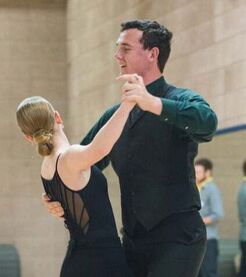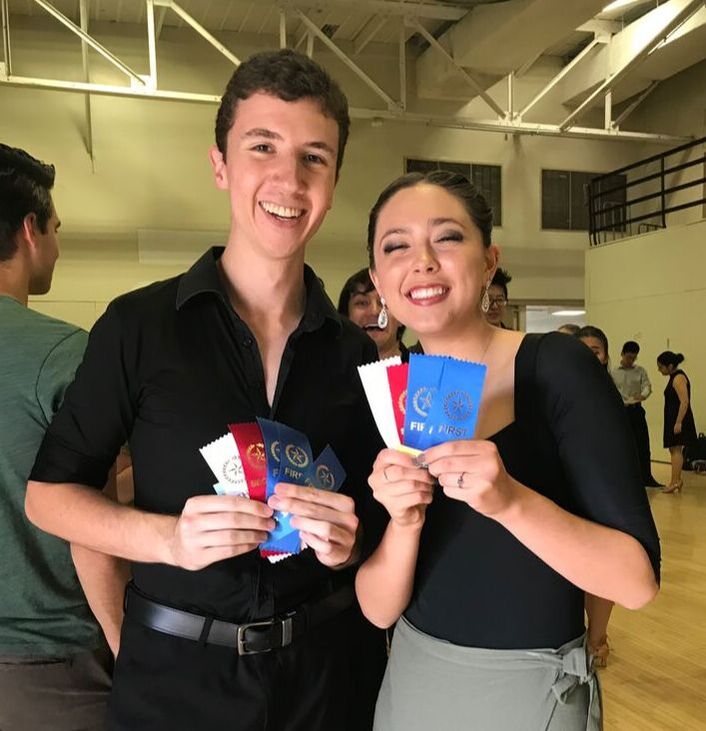A dance competition allows dancers to show and compare their skills with other dancers at a similar level. A competition consists of many events, each of which is targeted at a particular style of dance and skill level. Competition events are typically divided into Syllabus Events and Open Events:
Syllabus Levels

Each dance has a list of recognized steps associated with it. This list of steps is known as the “Syllabus” and consists of Bronze, Silver and Gold levels. The bronze level steps are fairly basic and provide a good grounding and understanding of the nature of each individual dance. The silver and gold levels add successively more difficult steps. Competitors in Syllabus Level events may only perform moves contained in the appropriate syllabus level(s) for that dance. Each syllabus level is described below:
bus level is described below:
Newcomer -The Newcomer level is usually reserved for dancers who are attending their first or second competition. Typically, this level is limited to dancers with less than half a year of experience. The newcomer level is a chance for new competitors experience competing without the stress of having to compete at the Bronze level (which often has dancers who have competed for some time). As a Newcomer, you may dance any figure in the Bronze syllabus.
Bronze – The Bronze level is often termed the beginner level. Dancers who are dedicated to constantly improving their dancing by mastering more advanced technique and patterns usually spend a year to a year and a half in Bronze. If you’re not all that serious about competition, you may hang out at the Bronze level for quite some time. It all depends on how much time you want to commit.
Silver – The Silver or intermediate level is for competitors who have a fine grasp of technique, and, in general who have consistently placed well in Bronze level competitions. Competitors in Silver are limited to the Bronze and Silver syllabi.
Gold – Gold level, or advanced, is a place for competitors to show their mastery of both technique and the entire syllabus for that particular dance/category. Here you may do any patterns in the Bronze, Silver, or Gold syllabi.
bus level is described below:
Newcomer -The Newcomer level is usually reserved for dancers who are attending their first or second competition. Typically, this level is limited to dancers with less than half a year of experience. The newcomer level is a chance for new competitors experience competing without the stress of having to compete at the Bronze level (which often has dancers who have competed for some time). As a Newcomer, you may dance any figure in the Bronze syllabus.
Bronze – The Bronze level is often termed the beginner level. Dancers who are dedicated to constantly improving their dancing by mastering more advanced technique and patterns usually spend a year to a year and a half in Bronze. If you’re not all that serious about competition, you may hang out at the Bronze level for quite some time. It all depends on how much time you want to commit.
Silver – The Silver or intermediate level is for competitors who have a fine grasp of technique, and, in general who have consistently placed well in Bronze level competitions. Competitors in Silver are limited to the Bronze and Silver syllabi.
Gold – Gold level, or advanced, is a place for competitors to show their mastery of both technique and the entire syllabus for that particular dance/category. Here you may do any patterns in the Bronze, Silver, or Gold syllabi.
Open Levels
The Open Levels do not have syllabus restrictions. Competitors are free to dance whatever moves they wish, as long as they are in the style of the dance they are competing in. Open Levels consist of the following:
Pre-Novice – The Pre-Novice level is intended for those dancers (usually Silver or Gold dancers) who are in the process of transitioning from closed syllabus routines to routines that incorporate some open figures.
Novice – The Novice level is intended for those dancers who have moved past the Pre-Novice level and are confident placed out of the syllabus events and/or have placed out of Pre-Novice.
Open – Pre-Championship & Championship – The Pre-Championship and Championship levels are intended for those dancers who have acquired the experience and skill to dance at these open levels beyond Novice.
Pre-Novice – The Pre-Novice level is intended for those dancers (usually Silver or Gold dancers) who are in the process of transitioning from closed syllabus routines to routines that incorporate some open figures.
Novice – The Novice level is intended for those dancers who have moved past the Pre-Novice level and are confident placed out of the syllabus events and/or have placed out of Pre-Novice.
Open – Pre-Championship & Championship – The Pre-Championship and Championship levels are intended for those dancers who have acquired the experience and skill to dance at these open levels beyond Novice.
Judging
|
During the event, 5 to 11 judges will rank the dance couples based on their skills, presentation, and showmanship. Scores from all the judges are combined to obtain the final standings. Adjudication is both an objective and subjective process and that is why several judges are used to ensure fairness. Depending on the number of entries, competitors may be required to compete in a series of elimination rounds (early rounds, quarter and semi-final) until six couples are recalled for the final round by the judges. During the final round, the placements, 1st through 6th, are determined.
|
What Judges Look For:
Experienced judges, having seen and studied dancing at all levels, can quickly assess these factors collectively:
Experienced judges, having seen and studied dancing at all levels, can quickly assess these factors collectively:
- Posture – one of the most important aspects. Good posture makes you look elegant and exude confidence. It improves balance and control, and allows your partner to connect well to your body in the smooth dances.
- Timing – if a couple is not dancing on time with the music, no amount of proficiency in any other aspect can overcome this.
- Line – this means the length and stretch of the body from head to toe. Attractive and wellexecuted
- Hold – the correct and unaffected positioning of the body parts when in closed dancing position. There should be symmetry in the man’s and woman’s arms coming together to form a circle, which, although changing in size, should remain constant in shape so that the dancers remain in correct body position relative to each other.
- Poise – in smooth & standard dancing, the stretch of the woman’s body upwards and outwards and leftwards into the man’s right arm to achieve balance and connection with his frame, as well as to project outward to the audience.
- Togetherness – the melding of two people’s body weights into one, so that leading and following appear effortless, and the dancers are totally in synchronization with each other.
- Musicality and Expression – the basic characterization of the dance to the particular music being played and the choreographic adherence to musical phrasings and accents.
- Presentation – the couple sells their dancing to the audience. They dance outwardly, with enthusiasm, exuding their joy of dancing and confidence in their performance.
- Power – Energy is exciting to watch. In a jive, often the most energetic couple that wins this dance. But the energy must be controlled, not wild.
- Foot and Leg Action – the sequential use of the four joints (hip, knee, ankle, and toes) to achieve fullness of action and optimal power; the use of inside and outside edges of feet to create style and line
- Shape – Shape is the combination of turn and sway to create a look or a position.
- Lead and Follow – the man leads with his whole body instead of just his arms and the lady follows effortlessly.
- Floorcraft – This refers not only to avoiding bumping into other couples, but the ability to continue dancing without pause when boxed in. It shows the command of the couple over their choreography and the ability of the man to choose and lead figures extrinsic to their usual work when the necessity presents itself.
- Intangibles – such as how a couple “looks” together, whether they “fit” emotionally, their neatness of appearance, costuming, the flow of their choreography, and basically whether they look like “dancers”; all have an effect on a judge’s perception and therefore on his markings.

